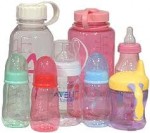 We aren't sure how Bisphenol A (BPA) (found in plastic food containers) affects human beings — especially developing fetuses and young children — and if concerning test results in animal subjects translate to people. Should BPA be banned from baby bottles, as it has been in other countries like Canada? Unfortunately, our ability to detect chemicals in our bodies is running ahead of our ability to understand exactly how them may affect us.
We aren't sure how Bisphenol A (BPA) (found in plastic food containers) affects human beings — especially developing fetuses and young children — and if concerning test results in animal subjects translate to people. Should BPA be banned from baby bottles, as it has been in other countries like Canada? Unfortunately, our ability to detect chemicals in our bodies is running ahead of our ability to understand exactly how them may affect us.
An estimated 93% of Americans have detectable levels of BPA in their bodies according to the Centers for Disease Control and Prevention. However, once we stop being exposed to the chemical, BPA levels can drop dramatically. We can rid ourselves of BPA fairly quickly, unlike other more long-lasting chemicals like lead.
That's the conclusion of a new study published in the journal Environmental Health Perspectives. A team of researchers from the Silent Spring Institute, the Breast Cancer Fund and Vassar College took five families from the San Francisco Bay area and had them stop using canned foods and plastic food packaging for several days. The scientists found that BPA levels among the family members dropped by an average of over 60% — but once they went back to their normal diet, the BPA levels went back up as well. That's pretty strong evidence that restricting use of certain plastics and packaging can significantly reduce exposure to the chemical, and whatever harm it may do.
Here's how the study worked: the five families of four provided urine samples for two days while they ate their normal diets. That gave researchers a background level for BPA and some phthalates — plasticizing chemicals that have also been tagged as endocrine disruptors (
naturally occurring compounds or man-made substances that mimic or interfere with the function of hormones in the body). Next, the researchers gave each family three days' worth of freshly prepared organic meals and snacks, stored in glass and stainless steel containers. (One popular source of BPA is in the liner inside canned food.) The families gave samples on the second and third days that were tested for BPA and phthalates. Lastly, the families returned to their normal diets for three days, and were tested twice again.
In addition to BPA, the researchers also tested for the phthalate DEHP — which is also found in food packaging — as well as DEP and several other chemicals that are not used often in packaging. That mix of chemicals was chosen to give the research team a better idea of the role that plastics and packaging might play in exposure to BPA. The fact that BPA levels among the families dropped when their diet changed — but levels of DEP, which is used in fragrances, didn't — underscores the importance of food packaging in exposing people to BPA.
Is this study significant? Although this research was peer-reviewed, it was a small study and one that was carried out by environmental groups that have raised concerns about BPA and other potentially toxic chemicals in the past. But if you are worried enough about BPA and phthalates to want to cut down your exposure, avoid canned foods and use glass or stainless storage containers. There are also more plastic products available that are BPA-free, including baby bottles.
Industry has registered its skepticism of this study and the the American Chemistry Council has stated:
This study simply confirms these reassuring points: that consumers have minute exposures to BPA and DEHP from food sources, and that the substances do not stay in the body, but are quickly eliminated through natural means. Additionally, data from U.S. Centers for Disease Control and Prevention and Health Canada have shown that typical consumer exposure to BPA and DEHP, from all sources, is up to 1,000 times lower than government-established safe exposure levels. “Consumers should feel confident that they can continue to eat healthy canned or packaged foods because materials intended for use in food contact are approved by the U.S. Food and Drug Administration."
EDITOR'S NOTE: This is an interesting article because it demonstrates how one study can be interpreted in several ways and why it is important to have large randomized controlled studies to get solid answers. The "experiment" above sounds like it was well designed but the numbers are extremely small so questions about bias, misinterpretation and control are very possible. The comment from the American Chemistry Council points out a common problem with epidemiology studies: when does small exposure turn into unsafe levels of exposure? This is one of the main reasons we cannot always prove cause and effect when we talk about environmental exposure. Because this latter organization represents the chemical industry, they too can be biased. The National Institute of Environmental Health Sciences and the National Toxicology Program are finding new ways to study the impact of chemicals, especially related to their effect on our hormones, which should help get some solid answers. BTW, I've stopped microwaving in plastic.

Comments